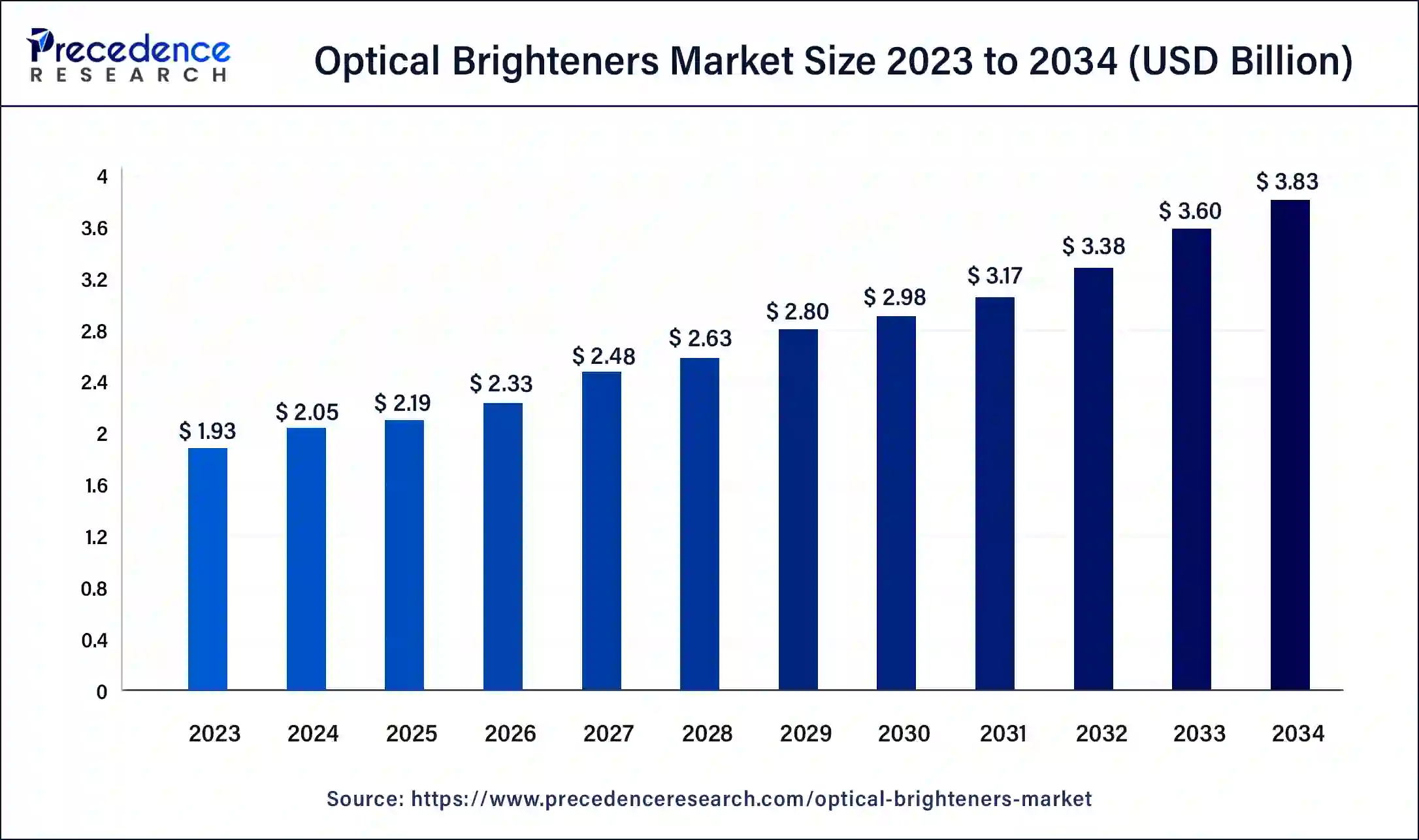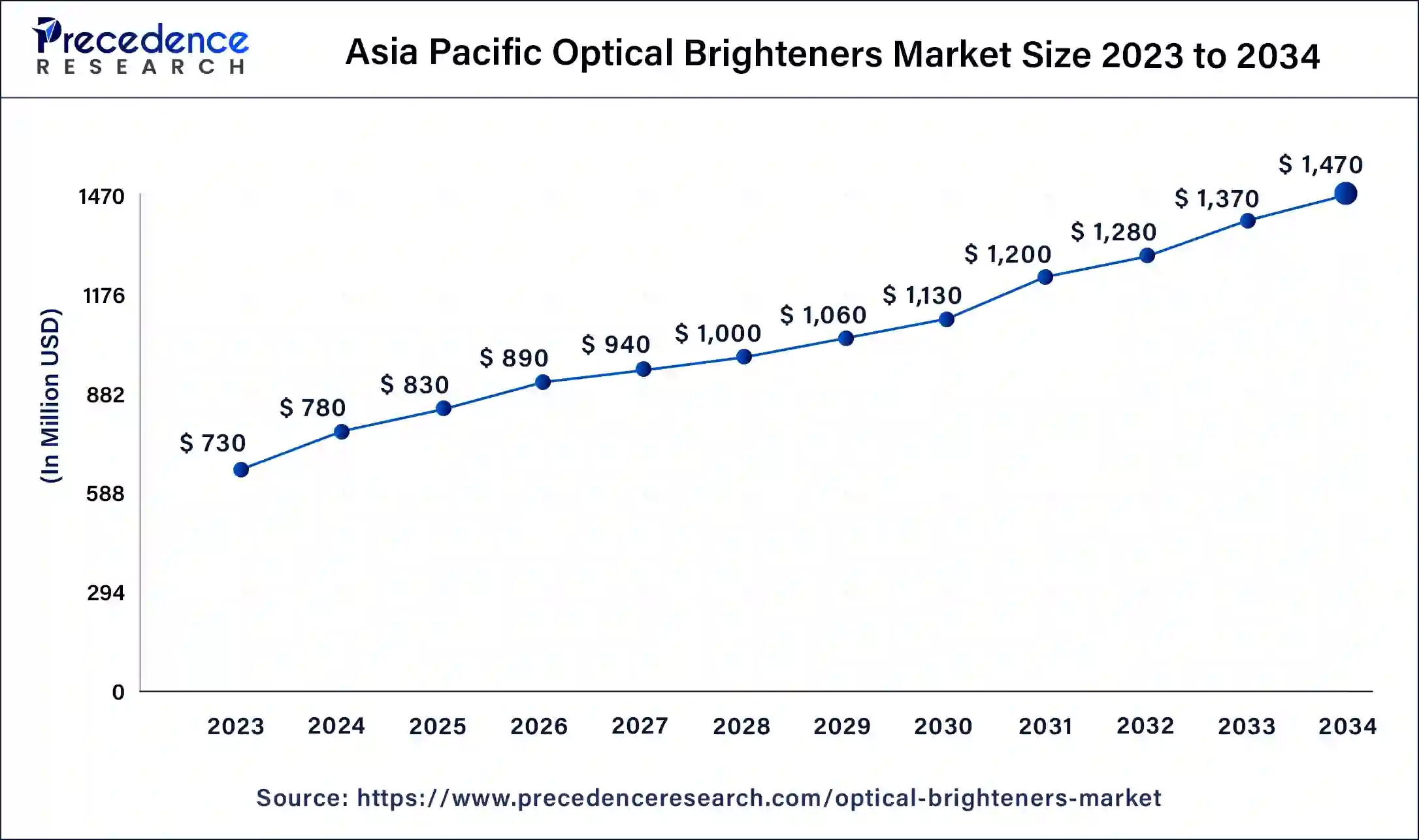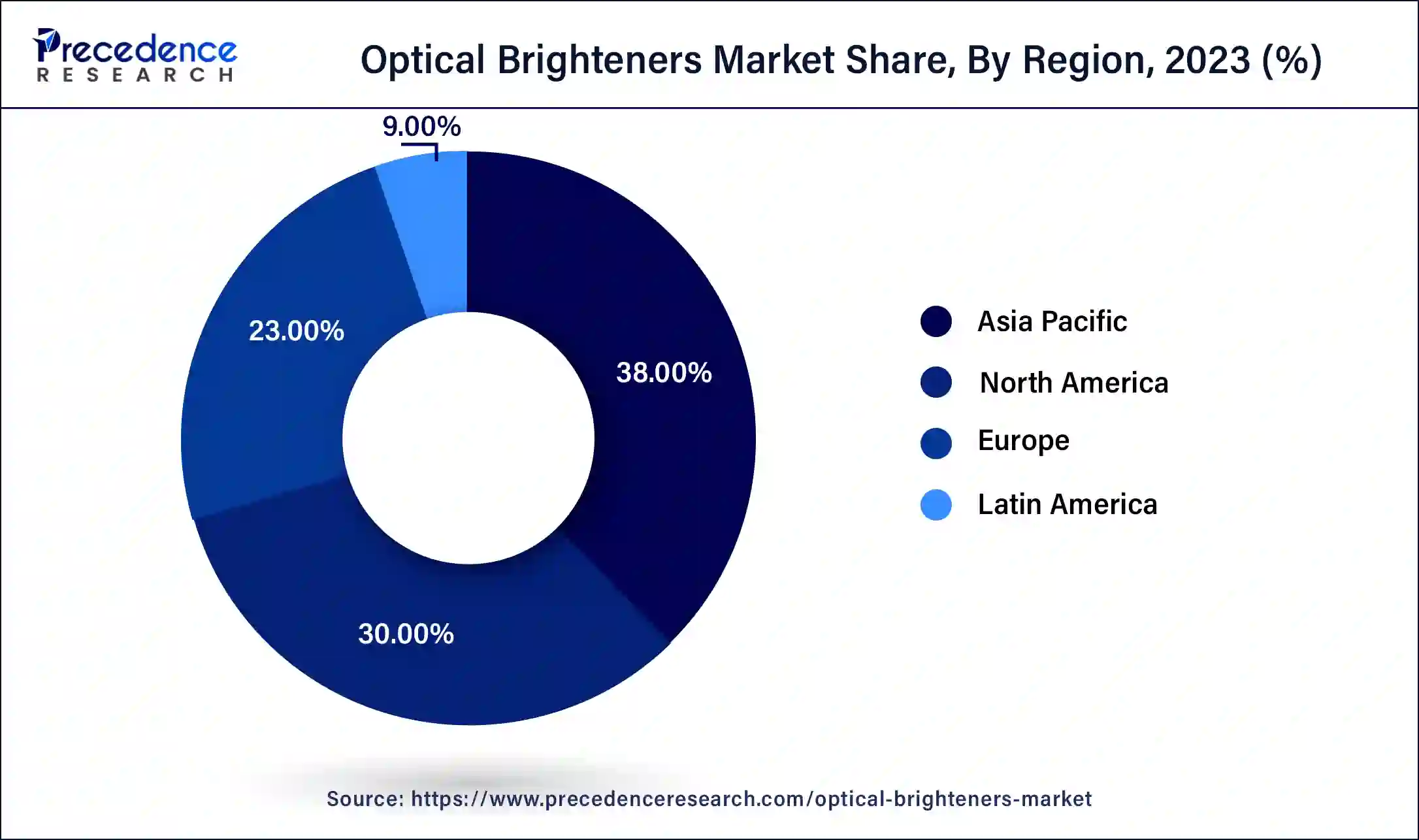January 2025
The global optical brighteners market size was USD 1.93 billion in 2023, calculated at USD 2.05 billion in 2024 and is expected to be worth around USD 3.83 billion by 2034. The market is slated to expand at 6.42% CAGR from 2024 to 2034.
The global optical brighteners market size is worth around USD 2.05 billion in 2024 and is anticipated to reach around USD 3.83 billion by 2034, growing at a CAGR of 6.42% over the forecast period 2024 to 2034. The increasing cosmetic industrial sector, increasing paper and packaging industry, rising demand in the textile industry, increased safety, cost-effectiveness, versatility, improved appearance, etc., driving the growth of the market.

The Asia Pacific optical brighteners market size was exhibited at USD 730 million in 2023 and is projected to be worth around USD 1,470 million by 2034, poised to grow at a CAGR of 6.57% from 2024 to 2034.

Asia Pacific dominated the optical brighteners market in 2023. Rising demand for optical brightener-based products like detergents and soaps is contributing to the growth of the optical brighteners market. The expansion of industries such as paper and textile industries in countries like India and China contributed to the market’s growth. Most of the optical brightening agents are exported from India to the U.S., Australia, and Bangladesh. Globally, the top 3 exporters of optical brightening agents are Indonesia, China, and India.

India is leading the world in optical brightening agent exports with 6180 shipments, China with 2352, and Indonesia with 708 shipments. The world imports most of its optical brighteners from India, China, and Indonesia. Globally, the top 3 importers of optical brighteners are India, Bangladesh, and Vietnam. India leads the world in optical brighteners imports with 4741 shipments, Bangladesh with 2619, and Vietnam with 2022 shipments.
North America is estimated to grow significantly during the forecast period. Increasing emphasis on good quality consumer products, constant advancement in product formulations, and strong industrial sector contributing to the growth of the optical brighteners market. The rising adoption of optical brighteners in many applications like security, textiles, detergents, paper, and packaging contributes to the growth of the growth of the market in the North American region. The strong manufacturing capabilities and advanced technologies are driving industrial expansion in the U.S.
The optical brighteners market refers to buyers and sellers of optical brighteners, which are synthetic chemicals added to liquid and detergent powder to make clothing appear cleaner, brighter, and whiter. Optical brighteners are also called fluorescent whitening agents (FWAs). Optical brighteners are chemical compounds that absorb light in the violet and ultraviolet regions of the electromagnetic spectrum and remit light in the blue region through the fluorescence phenomenon. Commonly, optical brighteners are used in laundry detergents to make cloth appear cleaner. Consumers do not like normally cleaned laundry, which appears yellowish. In many papers, optical brighteners are used mainly for high-brightness papers. Optical brighteners are used to brighten or color-correct additives in modern cosmetic formulas like eye makeup, conditioners, shampoos, etc.
How can AI improve the optical brighteners?
The use of artificial intelligence in optical brightener manufacturing and AI algorithm designs can improve processes and products, improving efficiency and reducing waste materials. AI helps in predictive maintenance and anticipating equipment failures by extending machinery life and minimizing downtime. The benefits of AI use in optical brighteners include enhanced worker safety, customization, greater flexibility, improved product quality, cost reduction, and increased productivity and efficiency, which helps the growth of the optical brighteners market.
| Report Coverage | Details |
| Market Size by 2034 | USD 3.83 Billion |
| Market Size in 2024 | USD 2.05 Billion |
| Market Growth Rate from 2024 to 2034 | CAGR of 6.42% |
| Largest Market | Asia Pacific |
| Base Year | 2023 |
| Forecast Period | 2024 to 2034 |
| Segments Covered | Chemical Type, Application, End-use, and Regions |
| Regions Covered | North America, Europe, Asia-Pacific, Latin America and Middle East & Africa |
Rising demand in the textile industry
In the textile industry, there is a rising demand for optical brighteners, which helps to the growth of the optical brighteners market. The use of optical brighteners in the textile industry includes many important steps, including adding them at the time of dying and finishing to improve the brightness and whiteness of fabrics. It can be applied by spraying, padding, or exhaustion to meet the specific needs of the textile product. The benefits of optical brighteners in the textile industry include safety, cost-effectiveness, versatility, and improved appearance.
Environmental considerations
The manufacturing and utilization of optical brighteners also have environmental involvement. Manufacturers must adopt renewable practices to minimize the environmental impact. The decreased use of sustainable sources like raw materials increases waste generation. Greenhouse gas emissions can increase due to their use. The optical brighteners have poor weather resistance. These factors can hamper the growth of the optical brighteners market.
Innovations in technology and regulatory compliance
Innovations in technology and regulatory compliance will help the growth of the optical brighteners market in the future. Strict regulations for chemicals used in products can help the market flow. Investing in the growth of e-commerce contributes to the growth of the market. Companies can be required to comply with many environmental regulations, which will help them formulate safer optical brighteners. Advancements in application and formulation technology are expected to create more versatile and effective optical brighteners by increasing their use in many applications.
The triazine-stilbene segment dominated the optical brighteners market in 2023. The triazine stilbenes are highly used as optical brighteners for whitening both wool and cotton. At the time of preparation of triazine-stilbene compounds, it is necessary to control the pH carefully to avoid unwanted hydrolysis of products that may reduce whiteness, which helps the growth of the market. The triazine-stilbene optical brighteners are highly used in industrial applications as whitening agents and for their synthetic procedures. These compounds show a high whiteness range with average UV-blocking properties. The UV absorption of the triazine-stilbene derivatives ranges from 240 to 450 nm. It is highly used in packaging, cosmetics, and textiles.
The coumarins segment is expected to be the fastest-growing during the forecast period. Coumarin is a versatile compound that proceeds as an important component in the design of photo-responsive polymers. Coumarins have different photochemical properties, such as their ability to go through dimerization upon exposure to UV light. Coumarins are natural bioactive compounds identified for their many beneficial properties. These factors help to grow the optical brighteners market. It is useful as a sunburn preventive, optical brightener, and fluorescence indicator. It helps to reduce the yellowish view of the materials.
The detergent brightener segment dominated the optical brighteners market in 2023. Optical brighteners are highly used for laundry detergents to improve the whiteness and brightness of fabrics. It helps to boost cleaning power, counter fabric yellowing, and make colored cloths look more vivid. Optical brighteners may loosen the stain bonds so the detergent can wash stains away more quickly and help to remove stains. Make clothes look brighter and whiter. These are the special dyes that absorb UV light and reflect it as blue light. The benefits of using optical brighteners in detergents include regulatory compliance, compatibility, and formulation development to maintain effectiveness and stability and to achieve the desired brightening effect.
The paper brightening segment is anticipated to grow significantly during the forecast period. Optical brighteners are used in paper brighteners. These types of chemical compounds absorb light from the ultraviolet and violet regions, normally in the 340-370 nm range, and remit light in the blue region, usually in the 420-470 nm range. It gives a fluorescent effect that reduces the yellowness of the fiber and improves the brightness of the paper product. To improve the whiteness and brightness of paper products, optical brighteners are added during the process of paper making and paper manufacturing. It also helps to achieve enhanced print quality and a uniform appearance. These factors help to grow the optical brighteners market.
The consumer products segment dominated the optical brighteners market in 2023. In consumer products like plastics, textiles, papers, and detergents, highly used optical brighteners are used to help the growth of the market. Optical brighteners absorb UV light and remit it as blue light, which helps improve the brightness and whiteness of materials and visual appeal. It is also used in color brightening or correcting additives in advanced cosmetic formulations like eye makeup, conditioners, and shampoos.
Segments Covered in the Report
By Chemical Type
By Application
By End-use
By Geography
For inquiries regarding discounts, bulk purchases, or customization requests, please contact us at sales@precedenceresearch.com
No cookie-cutter, only authentic analysis – take the 1st step to become a Precedence Research client
January 2025
January 2025